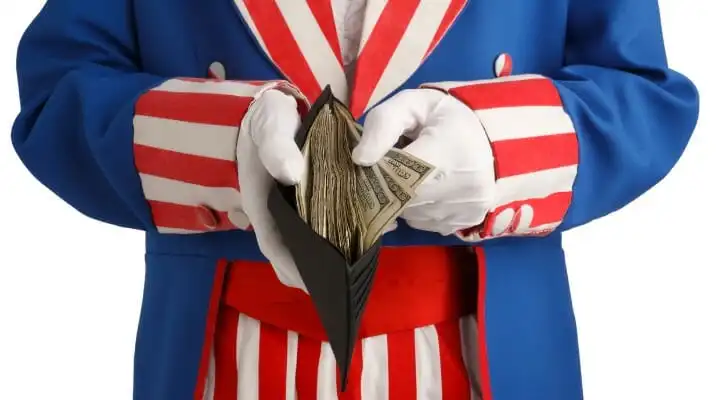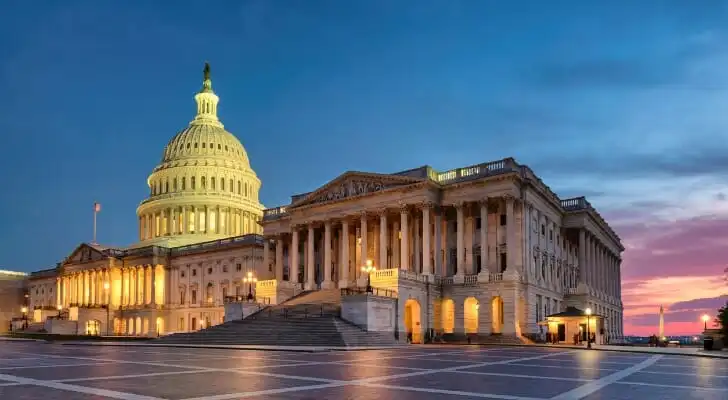Most people experience government spending through its fiscal policy, which refers to how a government takes money or spends it. The former happens through taxation, while the latter might include purchases of equipment and facilities and direct hiring.
The goal of fiscal policy is to help shape the economy by acting as what’s known as a “market participant.” Congress acts as a consumer or employer on a massive scale, and in doing so tips the balance of hiring and demand nationwide. Note that, unlike monetary policy, state and local governments can enact fiscal policy as well.
A financial advisor can help adjust your financial plan to protect investments from financial policy changes.
What Is Fiscal Policy?
The government has two main tools to influence the economy: fiscal policy and monetary policy. Monetary policy refers to government changing access to the money supply, shifting interest rates or changing the supply of money. It’s the domain of the U.S. central bank, known as the Federal Reserve. Fiscal policy refers to government initiatives to influence the economy by either spending or taxing. It’s the domain of Congress.
With fiscal policy the amount of money in the economy stays the same. Instead, the government changes how to use it. Spending policy lets the government put money into the hands of consumers by hiring people directly or sending them cash, and into the hands of businesses through purchasing programs (buying products and services on the open market). With taxing policy the government takes money out of the hands of consumers and businesses.
The Economy and Demand
According to the influential Keynesian economic theory, slowdowns are caused primarily by a shortfall in demand. This means that, for any number of possible reasons, consumers have begun spending less. This causes businesses to lose revenue and income. In response they generally lay off workers, reducing their expenses to meet the slowdown in demand, which leads these newly unemployed consumers to cut back on their spending even more in a vicious cycle.
Fiscal policy addresses this by having the government act as what’s called a “spender of last resort.” When consumers stop spending, the government buys products and services from those businesses instead, replacing that lost revenue. When businesses lay off workers, the government hires them instead, replacing that lost income.
There are generally two ways that fiscal policy manipulates demand: expansionary and contractionary policies.
Expansionary Fiscal Policy

Congress uses expansionary fiscal policy to fight recessions and to encourage economic growth.
When the economy slows down, whether from a sudden shock or a gradual process, Congress increases spending relative to taxation to put more money into the economy. It does this either by increasing spending or cutting taxes or both. The goal is to create what economists call a “virtuous cycle.” This works in three main ways:
Increase Consumer Spending
By cutting individual taxes, Congress can put more money in the hands of consumers. By hiring workers, it can do the same thing. In both cases, this gives individual consumers more money to spend. Ideally, consumers then spend that money at businesses, causing those businesses to hire more workers to respond to the increase in demand.
Increase Business Demand
By buying goods and services from business, Congress can directly increase demand. Ideally, these businesses will then hire workers to meet the new orders. Those workers will then have more money, which they can then spend at other businesses. Ideally, this will create a cycle of hiring and rising demand.
Increase Business Liquidity
By cutting corporate taxes, Congress can put more money in the hands of businesses. This stimulates businesses to spend money by hiring, buying equipment (capital expenditures) or expanding their operations. The new spending and hiring will in turn create demand elsewhere, leading other businesses to hire in an ongoing cycle. This is a core tenet of what is called “supply side” economics.
Economists debate which form of expansionary policy works best. However, most mainstream economists agree that expanding business liquidity does relatively little to grow the economy during a shortfall in consumer demand. Businesses spend money when they have customers. When they don’t, businesses tend to invest the money in securities or return it to investors in the form of dividends, or both, until consumer demand justifies hiring and expansion.
Contractionary Fiscal Policy
Under contractionary fiscal policy, Congress tries to fight inflation by slowing economic growth. It does this by adjusting spending-to-taxation ratios. Put another way, Congress taxes more than it spends on programs.
When an economy grows workers gain spending power. This is generally a good thing, as it indicates rising standards of living overall. The goal of economic growth is to allow everyone in the economy to share in prosperity.
However, the economy also has a limited capacity. This is known as “productivity,” the total amount of goods and services that the economy can produce every year. If purchasing power grows more quickly than productivity, people will soon be able to buy more goods and services than the economy can produce. This leads to inflation. As inflation spirals, basic products get more expensive, making them harder to buy and eroding standards of living.
By raising taxes, the government can reduce inflation.
Fiscal Policy: An Example Writ Small

To understand fiscal policy, it may be most helpful to consider a hypothetical small-scale economy.
Say that we have a baker and an economy with 10 employed people in it. Every day, the baker makes 10 cakes and sells them for $1 apiece. Everybody buys one cake per day.
Expansionary Policy
A recession occurs. Now our economy only has eight employed people in it, so two people stop buying cakes. Our baker’s income falls to $8 per day. She lays off staff to compensate. Now our economy has seven employed people in it. Fearing future layoffs, other consumers stop buying cakes. The baker now sells only six cakes per day and lays off someone else.
This is a recessionary cycle. To break it, the government starts buying two cakes per day. The baker re-hires a member of her staff. Our hypothetical economy now has eight employed people in it, allowing more people to buy cakes, allowing the baker to hire still more staff.
Contractionary Policy
However, we have gone too far. All 10 people in our economy are employed, but the government still buys two cakes per day while the baker can only make up to 10.
This means that two people per day cannot buy a cake. We have exceeded the economy’s productivity. So they offer to pay the baker $2 instead of $1 for a cake. The baker agrees, and the price of a cake goes up. Now the baker is making more money, so she raises her staff’s pay. Every day two people still go without a cake, but now consumers have more money in their pocket thanks to the raise. So now the last two people offer to pay $3 for a cake. The price goes up again.
This is an inflationary cycle. To break it, the government stops buying cakes and raises taxes. Now consumers have less money to spend. They can’t afford $3 cakes, so the baker drops her prices back down to $2, then to $1.
Bottom Line
Fiscal policy, unlike monetary policy, occurs when the government participates in the marketplace. To help cool down an overheated economy, it raises taxes so people and businesses will spend less. To help stimulate a sluggish economy, the government spends money hiring people and buying goods and services.
Tips for Investing in a Changing Economy
- A financial advisor can help you navigate a changing economy. Finding the right financial advisor who fits your needs doesn’t have to be hard. SmartAsset’s free tool matches you with up to three vetted financial advisors who serve your area, and you can interview your advisor matches at no cost to decide which one is right for you. If you’re ready to find an advisor who can help you achieve your financial goals, get started now.
- The 2020 economic downturn resulting from the coronavirus pandemic creates opportunities for investors. Read about how best to invest your money during an economic downturn.
Photo credit: ©iStock.com/lucky-photographer, ©iStock.com/DNY59, ©iStock.com/hedgehog94
